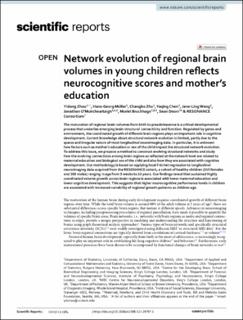| dc.contributor.author | Zhou, Yidong | |
| dc.contributor.author | Müller, Hans-Georg | |
| dc.contributor.author | Zhu, Changbo | |
| dc.contributor.author | Chen, Yaqing | |
| dc.contributor.author | Wang, Jane-Ling | |
| dc.contributor.author | O'Muircheartaigh, Jonathan | |
| dc.contributor.author | Bruchhage, Muriel Marisa Katharina | |
| dc.contributor.author | Deoni, Sean | |
| dc.date.accessioned | 2023-06-27T11:25:48Z | |
| dc.date.available | 2023-06-27T11:25:48Z | |
| dc.date.created | 2023-06-07T10:18:57Z | |
| dc.date.issued | 2023 | |
| dc.identifier.citation | Zhou, Y., Müller, HG., Zhu, C. et al. (2023). Network evolution of regional brain volumes in young children reflects neurocognitive scores and mother’s education. Scientific Reports, 13 (1), 2984. | en_US |
| dc.identifier.issn | 2045-2322 | |
| dc.identifier.uri | https://hdl.handle.net/11250/3073469 | |
| dc.description.abstract | The maturation of regional brain volumes from birth to preadolescence is a critical developmental process that underlies emerging brain structural connectivity and function. Regulated by genes and environment, the coordinated growth of different brain regions plays an important role in cognitive development. Current knowledge about structural network evolution is limited, partly due to the sparse and irregular nature of most longitudinal neuroimaging data. In particular, it is unknown how factors such as mother’s education or sex of the child impact the structural network evolution. To address this issue, we propose a method to construct evolving structural networks and study how the evolving connections among brain regions as reflected at the network level are related to maternal education and biological sex of the child and also how they are associated with cognitive development. Our methodology is based on applying local Fréchet regression to longitudinal neuroimaging data acquired from the RESONANCE cohort, a cohort of healthy children (245 females and 309 males) ranging in age from 9 weeks to 10 years. Our findings reveal that sustained highly coordinated volume growth across brain regions is associated with lower maternal education and lower cognitive development. This suggests that higher neurocognitive performance levels in children are associated with increased variability of regional growth patterns as children age. | en_US |
| dc.language.iso | eng | en_US |
| dc.publisher | Nature | en_US |
| dc.rights | Navngivelse 4.0 Internasjonal | * |
| dc.rights.uri | http://creativecommons.org/licenses/by/4.0/deed.no | * |
| dc.title | Network evolution of regional brain volumes in young children reflects neurocognitive scores and mother's education | en_US |
| dc.type | Peer reviewed | en_US |
| dc.type | Journal article | en_US |
| dc.description.version | publishedVersion | en_US |
| dc.rights.holder | The authors | en_US |
| dc.subject.nsi | VDP::Medisinske Fag: 700 | en_US |
| dc.source.volume | 13 | en_US |
| dc.source.journal | Scientific Reports | en_US |
| dc.source.issue | 1 | en_US |
| dc.identifier.doi | 10.1038/s41598-023-29797-1 | |
| dc.identifier.cristin | 2152501 | |
| cristin.ispublished | true | |
| cristin.fulltext | original | |
| cristin.qualitycode | 1 | |

